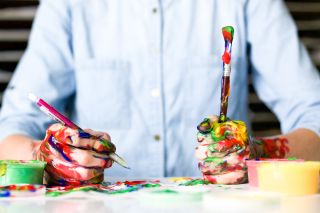Creativity
Uncovering Emotions in Creativity
A new book reveals how emotions inspire creative ideas.
Posted March 29, 2023 Reviewed by Vanessa Lancaster
Key points
- Quick idea generation, such as brainstorming sessions, benefits from pleasant, energized moods.
- Judging and selecting the best creative ideas will likely benefit from less-positive moods.
- Creativity takes a long time and requires us to manage emotional ups and downs. Emotion regulation abilities help through this process.

We tend to consider creativity in terms of thinking, such as coming up with ideas and solving problems. And indeed, those thinking processes are key to creating something new, original, and effective that can influence our personal lives or the world around us. However, why we decide to engage in creative work is often emotional, inspiration can come from emotional experiences, and we have to deal with emotional ups and downs on the long road from having an idea to transforming it into products and performances. The new Cambridge Handbook of Creativity and Emotions uncovers the latest science of emotions and creativity.
How can we study creativity and emotions?
When psychologists started studying the role of emotions in creativity, they asked which moods helped and which hurt creative thinking. They devised experiments in which they used different techniques to induce distinct moods. These techniques can range from asking people to recall personally meaningful memories (e.g., when they felt happy or sad), showing them videos with different emotional content, or presenting them with music to evoke particular moods. By inducing specific moods in the laboratory, scientists could be sure that any effects on creative thinking are due to one specific mood.
We have learned much from this research. A meta-analysis – a study that analyzes together the results of many previously published studies – showed unequivocally that positive energized moods benefit creative thinking. However, the authors cautioned that there are limits to this conclusion. Creative thinking benefits from happy moods only for a brief time, such as in quick brainstorming sessions. After a few minutes, the benefits of happy moods seem to disappear.
These studies showed the power of experiments that induce specific moods but also their limits. In real life, our emotions are richer and related to more immediately important experiences than those that can be induced in the laboratory. To understand those experiences, scientists need to supplement laboratory studies with in-depth case studies of creators, observations of creators, and studies of daily experiences that use technology to ask questions from creators at a scattering of times during the day to piece a picture of what they feel, how they think, and what they do.
What is the emotional side of the creative process?
We often hear creative individuals saying they must get in the right mood to work. The obvious question thus becomes, what is that mood? If we knew what mood enables creativity, we can put ourselves in those moods and, in that way, stimulate creativity.
It turns out that this is not a helpful question. Creativity involves different kinds of thinking – generating new ideas, reviewing and critically analyzing those ideas, selecting some (and abandoning others), imagining how to translate ideas into concrete products or performances, and trial and error. Although coming up with new ideas might be the first association with the word creativity, this is not sufficient. Monet did not just have an idea to paint the same scenes at different times of day and in different lights. He made multiple series of such paintings.
Positive, energized moods help us get started and have the initial burst of ideas flowing. Studies that follow people who work on long-term creative projects show that these are not the only moods that help creative engagement. Perhaps counterintuitively, unpleasant activated feelings – such as frustration, anger, or upset – are also related to more creative engagement. Such moods signal a problem that needs to be addressed, and as creators do so, their creativity grows.
Research also shows that creativity does not only (or primarily) depends on what we feel, but also on how we manage our feelings. Although some experiences hijack our emotional reactions (e.g., traumatic events), we can influence and modify what we feel in most life situations. This is the process of emotion regulation. When we regulate our emotions, we can manage how intensely we experience feelings (e.g., lowering stress to a moderate level), how we interpret emotion-triggering events (it helps to see them as challenges, as opposed to threats), and we can manage our resources (e.g., seek support to help when overwhelmed). And this helps us deal with the frustrations and stresses of creative work and come back up when we stumble.
Understanding the Emotions of Creative Individuals
To understand creative individuals' emotional lives, we must understand their psychological makeup and social and developmental influences on who they become. People’s typical daily feelings relate to every aspect of creative work. For example, passion predicts intentions for innovation-related work in the future, and curiosity predicts how often people experience flow, a state in which we are optimally engaged, self-assured, and perform at our highest level.
Some ways of feeling are more common in creators in specific domains of work. Artists tend to be emotionally sensitive and are more likely to show some symptoms of negative emotionality (such as depression, anxiety, and stress) than non-artists. The flip side is also true – those who are emotionally absorbed in life and attracted to using emotion, gut feelings, and empathy in making decisions – tend to be involved with the arts and show greater artistic accomplishment.
In addition to emotional traits, we must understand how social status or circumstances affect our feelings and creativity. For example, there are gender differences in both how people experience their everyday lives and their opportunities for creativity. Women face more strain-related feelings (e.g., being overwhelmed, tense, and frustrated) and experience less respect at work than men, and they have less support for creativity.
Emotional Side of Creative Activities
Creativity scholars have traditionally been focused on how emotions and our skills in dealing with them predict creativity. New research examines the effects of engaging with creative products and participating in creative activities on our emotional lives.
Art and artistic work is not the only kind of creativity, but it is a good example to examine the potential effects of interacting with creative objects. Art evokes feelings, from basic emotions (e.g., happiness or sadness), to knowledge-related emotions (e.g., curiosity, wonder, awe), and moral emotions (e.g., compassion, disgust). Emerging research shows a significant correspondence between the emotions of the audience and the emotions artists describe in their works. In other words, there is an empathic connection between creation and appreciation.
Creative arts therapies are effective in reducing emotional suffering and distress. But benefits of creative engagement are not limited to treating mental health symptoms. Creativity in our everyday lives can boost and build positive well-being. For example, drawing (especially to temporarily distract ourselves from unpleasant feelings) can repair mood. Everyday creative activities and creativity at work can also build a sense of purpose and meaning, contributing to our overall psychological well-being.
Creativity and Emotions at School and Work
In real life, creativity most prominently happens in the context of schools and work. Developmental psychologists have documented a phenomenon they termed creative mortification – completely losing the willingness to engage in a creative activity brought up by overwhelming self-conscious emotions after getting harsh negative feedback. For example, after being publicly berated by a teacher in art class, a student never wants to draw again. Such creative mortification is more common in younger students who have not yet learned to manage their emotions successfully.
But creativity, by definition, involves a certain level of unpleasant uncertainty and risk. On the one hand, too much anxiety can prevent creativity, but on the other, avoiding uncertainty also precludes creativity. To create opportunities for the development of creativity, curricular experiences have to provide an optimal level of uncertainty, not too little (so that students are forced to follow a strict set of steps) and not too much (so that students are overwhelmed and are not able to imagine being successful). Students build their creative confidence with repeated encounters with uncertainty, such as open-ended assignments.
In the workplace, creativity is social in nature. Creativity happens in teams and depends on the emotional climate and the nature of interactions with others. Key to creativity is the sense of psychological safety, a belief that it is safe to take risks at work, especially risks to one’s reputation. Importantly, Amy Edmondson pioneered this research and noted that psychological safety is “neither a careless sense of permissiveness, nor an unrelentingly positive affect but, rather, a sense of confidence that the team will not embarrass, reject, or punish someone for speaking up.
This confidence stems from mutual respect and trust among team members.” When this sense of safety exists, people can take risks, voice their ideas, and work through them. Psychological safety is that ingredient that allows teams to move from having disagreements about ideas to learning from different perspectives and end up with more creative and successful outcomes.
In addition to enabling the broadening of thinking and building on it, a creativity-enhancing emotional climate contributes to a sense of social connectedness and integration. Not all conflict is created equal, and although conflict about work tasks and ideas can be productive and stimulate creativity, interpersonal conflict tends to suppress it.
As we ask about the role of emotions in creativity, we must attend to what we feel at different times, what feelings our environment (especially others around us) inspire or impose, and how to deal with feelings skillfully. Emotions can inspire creative thinking and fuel us to persist through the long process of making ideas happen.
References
Ivcevic, Z., Hoffmann, J. D., & Kaufman, J. C. (2023). Cambridge Handbook of Creativity and Emotions. Cambridge University Press.




